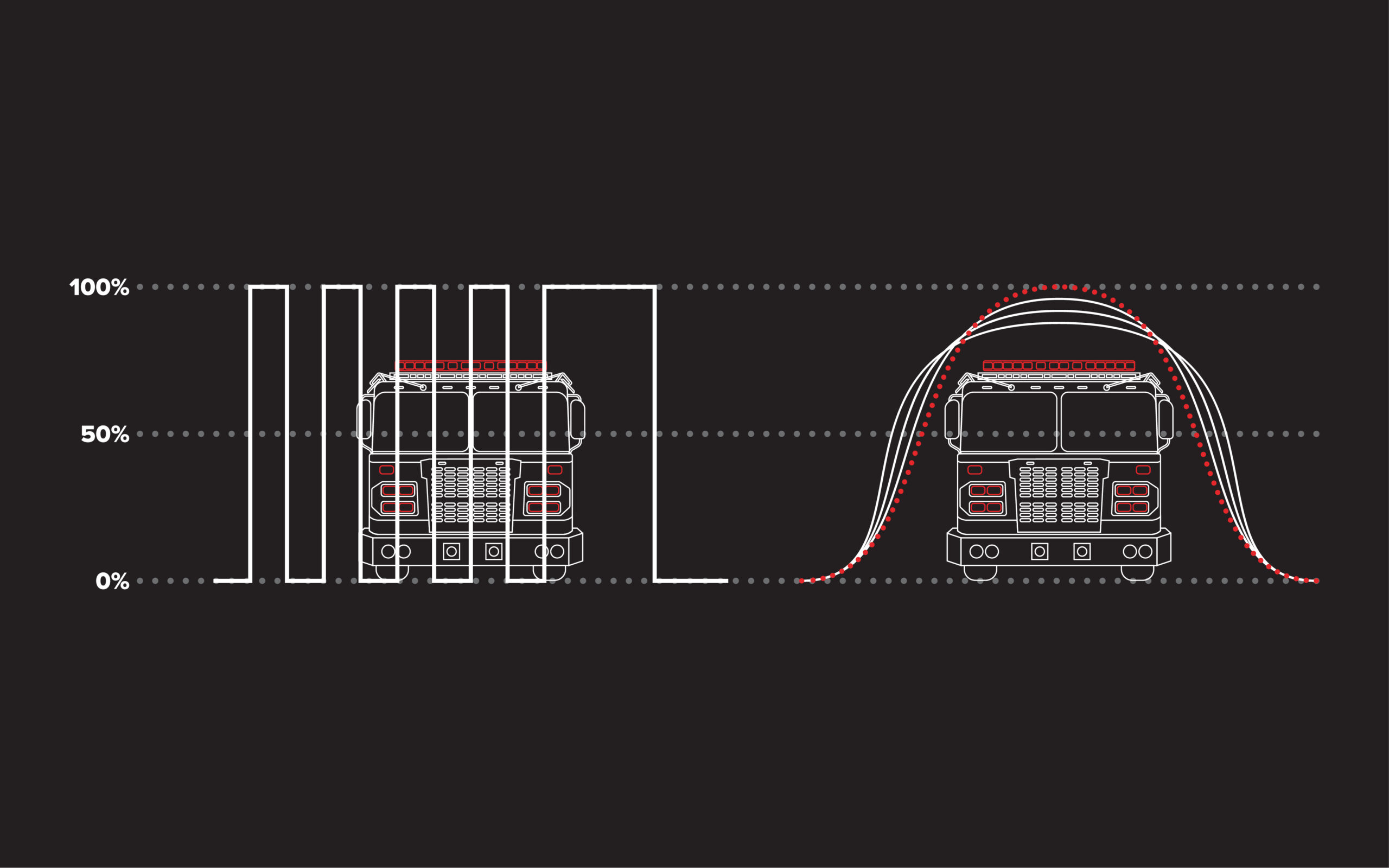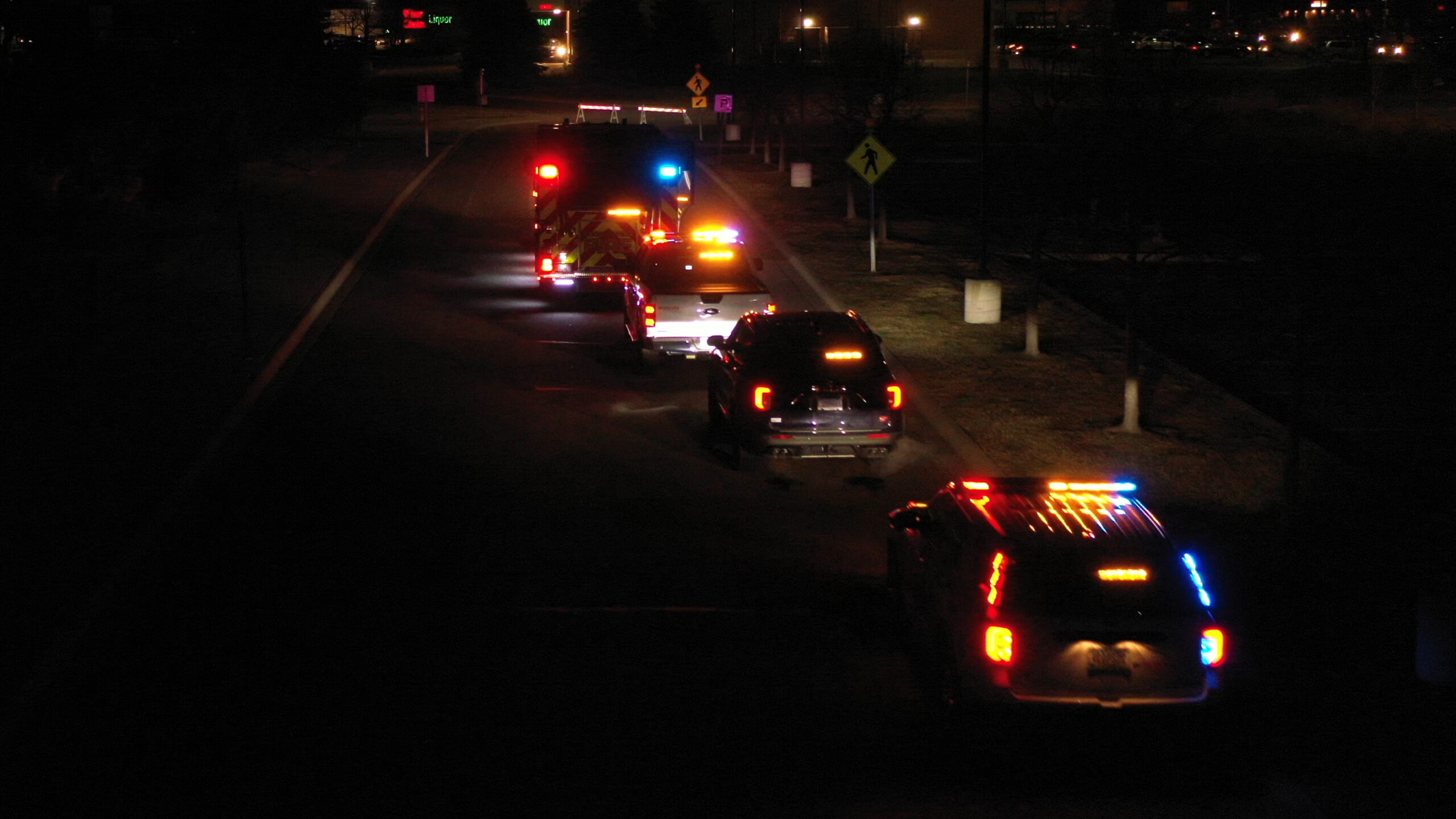Four Key Features That Enhance Nighttime Safety for Everyone
This article was first published in the September 2022 edition of Fire Apparatus & Emergency Equipment.
By Jim Stopa
Enhancing nighttime safety is an industrywide initiative that has been increasing in importance over the past several years.
Fleet managers, first responders, and the motoring public all have a personal stake in seeing increased nighttime safety. Lighting studies and the science behind them continue to guide the direction of the newest safety enhancements that are brought to market. Today, there are four critical lighting features to consider to ensure apparatus are optimized for a calm and safe nighttime emergency scene.
LOWERING INTENSITY
LEDs have brought tremendous intensity and efficiency gains since manufacturers started using them for warning technology in the early 2000s. The lumens per watt efficacy has constantly increased year after year, which is critical when warning the public in the bright daytime sun. However, because of glare, finding a balance to this intensity at night has become an ongoing and increasing theme for apparatus. Traditional thinking says that brighter is better, but that is starting to change according to Dr. John Bullough, the program director for population health science and policy at the Icahn School of Medicine at Mount Sinai in Albany, NY. “It’s beginning to sink in because 5 to 10 years ago, even just the suggestion that there may be times when you might want to reduce the intensity, people would say, ‘That’s foolish.’ But now you know, only a few would say that. So, it’s changing,” Bullough says. Bullough is a leading industry expert who directs research in transportation lighting and safety at the school’s Light and Health Research Center. He has served as primary investigator for studies sponsored by the National Highway Traffic Safety Administration, the Federal Highway Administration, the Fire Protection Research Foundation of the National Fire Protection Association, the Emergency Responder Safety Institute, and others.
While more research is needed to identify ideal nighttime intensity standards, if Bullough’s instincts are correct, lowering light intensity does contribute to a calmer nighttime scene. “I think when you have a situation where vehicles are stopped or parked, my sense is that’s a time when slowing the lights down, turning down the intensity, using a simpler flash pattern, and synchronizing things would be a bit more helpful,” Bullough says, when asked what would make nighttime emergency scenes safer. “Where you can then begin to try to allow people to pick out what’s going on. Because you just know there’s something not good going on up ahead, but you don’t have any sense of what’s happening until you’re on top of it. So, I think any way to calm things down and help the traffic get where it needs to go would be helpful,” he continues.
REMOVING EDGES
While lowering the intensity is a crucial safety feature at night, other leading innovations further enhance comfort and reduce glare, like removing all flash edges in a flash pattern. In 2019, a new feature called Dynamic Variable Intensity (DVI) was introduced by Whelen Engineering. This innovative technology enables the creation of light patterns that gradually increase or decrease the light’s output intensity, which better conveys visual information to approaching motorists at night. These patterns clearly indicate when an emergency vehicle is parked and improve a driver’s ability to navigate around an emergency scene safely, while meeting all optical requirements of NFPA and SAE standards.
I have shown in nighttime outdoor demonstrations that viewing multiple warning lights in a random multiflash pattern causes the human body to tense up, and removing the flash edges calms it down. By quickly switching to a flash pattern with no flash edges as with DVI, one’s body relaxes and the stress is gone. Stress in the motoring public around an emergency scene at night is something that does not have to happen with today’s technology.

SLOWER FLASH PATTERNS
The third critical area of lighting that should be examined is flash patterns. According to Bullough, light can affect drivers’ sense of time and stress levels when approaching an accident scene at night. “It’s like when we were going through the transition to LED traffic lights. LEDs snap on and off instantly if you want them to, whereas with incandescent traffic lights, there is a little bit of a rise time to come on. And just like that Mach band effect where if you look at the stripes where the stripes get increasingly bright, right near the edge is where you see this bigger brightness difference than what’s actually physically there. It turns out that there’s a similar effect with time,” Bullough says.
“So, in other words, as you go from an instantaneously dark to bright or bright to dark visually, that ends up appearing from our perception like a bigger difference than it actually is. At the time it was not of terrible significance because the transitions are infrequent between a green, yellow, and red traffic light. But here you have a situation where you’re flashing lights on a pretty regular cycle, at least 60 times a minute, and you have a number of them. So, with all those flashes there is a physiological reason that it feels uncomfortable,” Bullough states. Slowing the flashes per minute down allows the motoring public to better absorb their surroundings, process the environment, and feel more at ease as they navigate the roadway.
SYNCHRONIZED FLASH PATTERNS
The final lighting feature to consider for enhancing nighttime safety is synchronized flash patterns. The control-system technology, also known as Vehicle-to-Vehicle Synchronization (V2V Sync), enables fleet managers and users to automatically synchronize lights and tones on multiple vehicles. This groundbreaking idea was also pioneered by Whelen Engineering. Bullough has studied the effectiveness of synchronization and discovered that drivers have quicker response times when lights are synchronized. “People do seem to feel like it would be easier to drive past those lights when they’re slower or synchronized, or a simpler pattern,” Bullough says. “We’ve done these studies where you have the plywood cut-out of a silhouette of a firefighter or a police officer and it does seem like people can figure out where that person is a little more quickly when the lights are more coordinated, as opposed to every light randomly doing its own thing,” Bullough states. Much of the fine-tuning in V2V Sync is done through software that is driven off a centralized system. Synchronized flash patterns can also be embedded directly into essential premium products to support OEMs and sophisticated installations. It is always recommended that you check with the manufacturer to ensure your lighting system meets your applicable standards when calibrating day/night lighting intensity modes.

Lowering light intensity, removing flash edges in a flash pattern, using slower flash patterns, and synchronizing flash patterns among vehicles are all critical components of creating a calmer and safer nighttime scene. As more studies are completed around nighttime safety, manufacturers will continue to adapt to new discoveries by developing innovative technologies designed to increase safety for both the motoring public and first responders.
JIM STOPA worked for 48 years at Whelen Engineering, starting as an electronic technician and climbing the ladder to become an associate electrical engineer, senior electrical engineer, then chief electronic design engineer and electrical department manager, retiring in January 2022. He is credited with 22 patents and is an active participant in many standards groups, such as Society of Automotive Engineers, National Fire Protection Association, Ambulance Manufacturers Division, Fire Apparatus Manufacturers’ Association, and Fire Department Safety Officers Association. Today, he works as a part-time consultant, writes white-paper articles, and speaks at technical conventions, educating the industry about emergency warning technologies.



